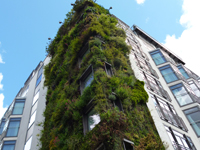ZTC in News
ZTC IN MEDIA
The article published in Financial Chronicle on 5th July 2012 quoting the expertise of Landscape Engineering Team of ZTC International about the Vertical Garden Technology.
 SPACE is a big constraint in every city. As houses and buildings go vertical to make most of the available space, gardens too can be
grown upwards. For those, who love to have a
tiny patch of green in their premises, the most
appropriate way is going vertical. Vertical gardens or
green walls are increasingly becoming popular in Indian
cities. It is a garden on the wall which partially or
completely covers the wall with vegetation, and can be
grown in all climatic conditions – hot, humid, dry, saline or cool.
SPACE is a big constraint in every city. As houses and buildings go vertical to make most of the available space, gardens too can be
grown upwards. For those, who love to have a
tiny patch of green in their premises, the most
appropriate way is going vertical. Vertical gardens or
green walls are increasingly becoming popular in Indian
cities. It is a garden on the wall which partially or
completely covers the wall with vegetation, and can be
grown in all climatic conditions – hot, humid, dry, saline or cool.
According to Hema Kumar, managing director of Bangalore-based ZTC International Landscape Solutions – one of the pioneers in vertical landscaping in India – the acceptance of the concept has grown rapidly over the past few years. Seven years ago, when he started sharing the concept of vertical garden with professionals and displayed the modular green wall system in some of the conferences, most of them didn’t believe that vertical gardens could really exist."However, in the past three to four years, there has been a total turnaround, and almost every architect is trying to implement vertical garden in some of their projects. One of the main reasons is the fast-growing green movement. Hyderabad International Airport was the first green wall project in India, and at that time, it was also the first tallest indoor green wall in Asia Pacific," he said.
Vertical gardens serve several purposes apart from being visually appealing. They cool the sides of a building from direct sunlight, provide an extra layer of insulation, reduce outdoor noise, improve air quality and provide additional points for green buildings. The modern concept of green wall was popularised by Patrick Blanc, the French botanist. His style of vertical garden is called ‘Le Mur Vegetal’. The different types of vertical gardens popular today are bio-walls, modular green walls, living walls and creeper walls.
A vertical garden needs a strong structural design to ensure that the walls are not affected by the moisture of the garden and no part of the garden drops down. A soil-less medium is used to grow the plant as soil proves to be heavy for a vertical garden. This medium also should retain the right amount of water. Another important factor is the choice of the plants as per the climatic conditions of the city. “Delhi has an extreme hot and cold climate, while Chennai and Mumbai have saline air. Most of the plants do well in Bangalore, Pune and Hyderabad,” said Kumar. Vegetables, leafy plants, as well as flowering plants, go well in a vertical garden. Among vegetable plants, tomatoes, small melons, cucumbers, peas, pole beans and grapes grow well vertically. Perennial plants like clematis, bougainvillea, climbing roses, wisteria, trumpet vine, climbing hydrangea, ivy, jasmine and passion flower come under the flowering category. Different types of vines add to the green cover.
Initial design is very important for the proper working of drip irrigation, drainage, and fertigation system. This solves 80 per cent of the maintenance related issues for the vertical garden once it is installed. The daily maintenance is the same as any horizontal garden would also require,” he said. A professionally done vertical garden can cost anywhere between Rs 1,000 and Rs 3,000 per sq ft. According to him, apprehensions about plants harming the strength and texture of walls are baseless. "If the vertical garden is conceptualised and designed by a professional, the garden does not harm the wall in any way. Actually green gardens help to protect the building against the temperature difference and the rain",he added.
SANGEETHA G
sangeethag@mydigitalfc.com

